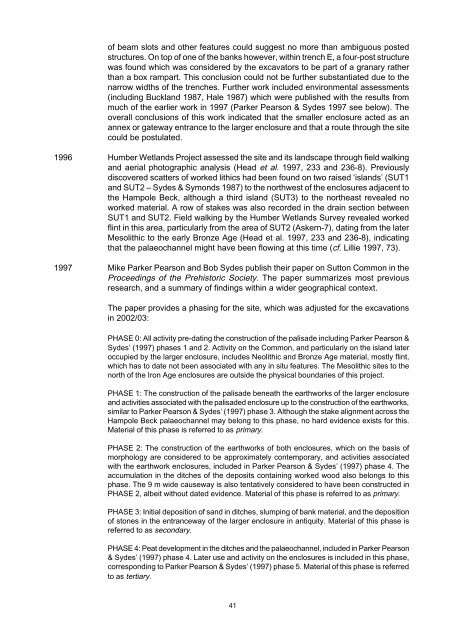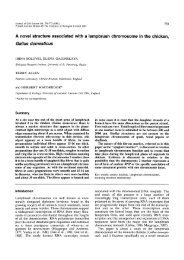Sutton Common Updated project design - University of Exeter
Sutton Common Updated project design - University of Exeter
Sutton Common Updated project design - University of Exeter
Create successful ePaper yourself
Turn your PDF publications into a flip-book with our unique Google optimized e-Paper software.
<strong>of</strong> beam slots and other features could suggest no more than ambiguous posted<br />
structures. On top <strong>of</strong> one <strong>of</strong> the banks however, within trench E, a four-post structure<br />
was found which was considered by the excavators to be part <strong>of</strong> a granary rather<br />
than a box rampart. This conclusion could not be further substantiated due to the<br />
narrow widths <strong>of</strong> the trenches. Further work included environmental assessments<br />
(including Buckland 1987, Hale 1987) which were published with the results from<br />
much <strong>of</strong> the earlier work in 1997 (Parker Pearson & Sydes 1997 see below). The<br />
overall conclusions <strong>of</strong> this work indicated that the smaller enclosure acted as an<br />
annex or gateway entrance to the larger enclosure and that a route through the site<br />
could be postulated.<br />
1996 Humber Wetlands Project assessed the site and its landscape through field walking<br />
and aerial photographic analysis (Head et al. 1997, 233 and 236-8). Previously<br />
discovered scatters <strong>of</strong> worked lithics had been found on two raised ‘islands’ (SUT1<br />
and SUT2 – Sydes & Symonds 1987) to the northwest <strong>of</strong> the enclosures adjacent to<br />
the Hampole Beck, although a third island (SUT3) to the northeast revealed no<br />
worked material. A row <strong>of</strong> stakes was also recorded in the drain section between<br />
SUT1 and SUT2. Field walking by the Humber Wetlands Survey revealed worked<br />
flint in this area, particularly from the area <strong>of</strong> SUT2 (Askern-7), dating from the later<br />
Mesolithic to the early Bronze Age (Head et al. 1997, 233 and 236-8), indicating<br />
that the palaeochannel might have been flowing at this time (cf. Lillie 1997, 73).<br />
1997 Mike Parker Pearson and Bob Sydes publish their paper on <strong>Sutton</strong> <strong>Common</strong> in the<br />
Proceedings <strong>of</strong> the Prehistoric Society. The paper summarizes most previous<br />
research, and a summary <strong>of</strong> findings within a wider geographical context.<br />
The paper provides a phasing for the site, which was adjusted for the excavations<br />
in 2002/03:<br />
PHASE 0: All activity pre-dating the construction <strong>of</strong> the palisade including Parker Pearson &<br />
Sydes’ (1997) phases 1 and 2. Activity on the <strong>Common</strong>, and particularly on the island later<br />
occupied by the larger enclosure, includes Neolithic and Bronze Age material, mostly flint,<br />
which has to date not been associated with any in situ features. The Mesolithic sites to the<br />
north <strong>of</strong> the Iron Age enclosures are outside the physical boundaries <strong>of</strong> this <strong>project</strong>.<br />
PHASE 1: The construction <strong>of</strong> the palisade beneath the earthworks <strong>of</strong> the larger enclosure<br />
and activities associated with the palisaded enclosure up to the construction <strong>of</strong> the earthworks,<br />
similar to Parker Pearson & Sydes’ (1997) phase 3. Although the stake alignment across the<br />
Hampole Beck palaeochannel may belong to this phase, no hard evidence exists for this.<br />
Material <strong>of</strong> this phase is referred to as primary.<br />
PHASE 2: The construction <strong>of</strong> the earthworks <strong>of</strong> both enclosures, which on the basis <strong>of</strong><br />
morphology are considered to be approximately contemporary, and activities associated<br />
with the earthwork enclosures, included in Parker Pearson & Sydes’ (1997) phase 4. The<br />
accumulation in the ditches <strong>of</strong> the deposits containing worked wood also belongs to this<br />
phase. The 9 m wide causeway is also tentatively considered to have been constructed in<br />
PHASE 2, albeit without dated evidence. Material <strong>of</strong> this phase is referred to as primary.<br />
PHASE 3: Initial deposition <strong>of</strong> sand in ditches, slumping <strong>of</strong> bank material, and the deposition<br />
<strong>of</strong> stones in the entranceway <strong>of</strong> the larger enclosure in antiquity. Material <strong>of</strong> this phase is<br />
referred to as secondary.<br />
PHASE 4: Peat development in the ditches and the palaeochannel, included in Parker Pearson<br />
& Sydes’ (1997) phase 4. Later use and activity on the enclosures is included in this phase,<br />
corresponding to Parker Pearson & Sydes’ (1997) phase 5. Material <strong>of</strong> this phase is referred<br />
to as tertiary.<br />
41
















